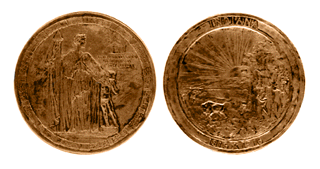
The Story of the Medal
The following information is taken from The Indiana Medal a 32-page booklet published by the Indiana Historical Commission in Indianapolis in 1916.
To design this commemorative medal the Indiana historical Commission chose the sculptor, Janet Scudder, a daughter of Indiana whose reputation is international.
Miss Scudder was born in the city of Terre Haute. She studied at several of the important art academies of the United States and in Paris and with Taft and Macmonnies. Notable examples of her work are the Frog Fountain in the Metropolitan Museum, New York, the Fighting Boys Fountain in the Chicago Art Institute, medallion portraits at the Musée du Luxembourg in Paris and in the John Herron Art Institute at Indianapolis and the façade of the Brooklyn Museum of Arts and Science.
While engaged in designing the Indiana medal, Miss Scudder has also been at work on a medal for the United States Government, to be presented to the South American Commissioners of mediation between this country and Mexico.
The Indiana medal, which is done in delicate low relief, shows on the obverse side an allegorical representation of the baby state of 1816 being welcomed to the Union, while in the distance are seen the historic little state house at Corydon and the Constitution Elm, both of which are still standing.
On the other side is the State Seal. The origin of the design for this seal is obscure. The first constitution provided for a state seal, and in the House Journal of 1816 the design is defined as:
A forest and a woodman felling a tree, a buffalo leaving the forest and fleeing through the plain to a distant forest, and the sun setting in the west, with the word 'Indiana.'
The design that was made has been generally understood as showing a rising sun with the buffalo fleeing to the west. It is not known who designed this seal nor is there any record that it was ever officially adopted. The sum of one hundred dollars was appropriated by the legislature, on December 13, 1816, to pay for a seal and press. On a slavery petition on file at Washington, dated 1802, is an impression of the seal of Indiana territory which has the same general character.
In modeling the seal for the medal Miss Scudder has followed the general design, which has been so familiar for a century, but she has refined its crudities and made a seal that is a thing of beauty.
The medallic art has been happily defined as the link between sculpture and painting. While the history of coins and medals is inseparable, the medal as we think of it to-day is an artistic production intended for a memorial piece and not used as currency.
The coinage of Greece and Rome, beautiful in design and representing the highest art of the day, while often having a truly medallic character, was intended for general circulation, and their "Medallions," which were so large as to have been evidently intended to be used solely as records of personal achievement, seldom had the commemorative character of the medal proper. The modern development of the medal grew out of the wonderful artistic renaissance in Italy, from which so many forms of our highest art derive their inspiration.
It is in France that the medal as it is now understood has been brought to the greatest perfection. There it is used to commemorate public events, to record the deeds of distinguished men and also for important private celebrations. Many of the greatest artists of that country have taken pride in the production of such medals, some of which are regarded as artistic masterpieces.
All of the early medals were cast, but in the sixteenth century the use of dies began, which make possible a much greater number of fine copies. At first it was necessary for a medalist to cut by hand the steel dies with which they are struck, but in 1839 a quite wonderful machine was invented and first exhibited in Paris that will perfectly render in steel the work modeled by the sculptor on a larger scale in wax or some similar plastic substance. This machine, retaining every characteristic of the artist's model, has greatly simplified and improved the art of medal making and has made possible the extensive modern revival of the art.
The best examples of the medals of to-day are the result of the exercise of as great an artistic ability as is required for any other form of art. While they may vary greatly in treatment, they are marked by beauty and imagination and they reflect faithfully the spirit of their time. In this form of imperishable bronze artists are preserving for posterity records that, as time goes by, will be treasured more and more.
-Lee Burns.
